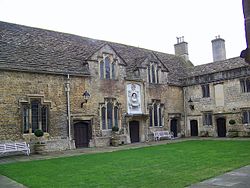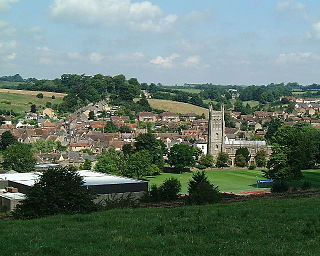
Bruton is a market town, electoral ward, and civil parish in Somerset, England, on the River Brue and the A359 between Frome and Yeovil. It is 7 miles (11 km) south-east of Shepton Mallet, just south of Snakelake Hill and Coombe Hill, 10 miles (16 km) north-west of Gillingham and 12 miles (19 km) south-west of Frome. The town and ward have a population of 2,907. The parish includes the hamlets of Wyke Champflower and Redlynch. Bruton has a museum of items from the Jurassic era onwards.
Wells Cathedral School is a co-educational independent day and boarding school located in Wells, Somerset, England. The school is one of the five specialist musical schools for school-age children in the United Kingdom, along with Chetham's School of Music, the Yehudi Menuhin School, the Purcell School and St. Mary's Music School, Edinburgh. The Head Master, Alastair Tighe, is a member of the Headmasters' and Headmistresses' Conference.

Sexey's School is a Church of England, co-educational state boarding and day school in Bruton, Somerset, England for 11-18 year olds. Sexey's School is named after Hugh Sexey who, in 1599, was appointed as a Royal auditor to Elizabeth I and later as a Royal auditor to James I. Sexey's Hospital was established in 1619 from the proceeds of his will, and the school was founded in 1889. State boarding schools are most unusual in England and Wales. The school became an academy in August 2011.

There are 100 Grade I listed buildings in Bristol, England according to Bristol City Council. The register includes many structures which for convenience are grouped together in the list below.

The Grade I listed buildings in Somerset, England, demonstrate the history and diversity of its architecture. The ceremonial county of Somerset consists of a non-metropolitan county, administered by Somerset County Council, which is divided into five districts, and two unitary authorities. The districts of Somerset are West Somerset, South Somerset, Taunton Deane, Mendip and Sedgemoor. The two administratively independent unitary authorities, which were established on 1 April 1996 following the breakup of the county of Avon, are North Somerset and Bath and North East Somerset. These unitary authorities include areas that were once part of Somerset before the creation of Avon in 1974.
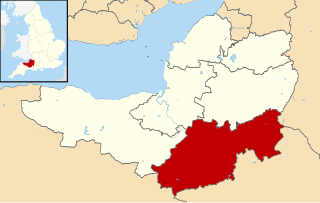
South Somerset is a local government district in the English county of Somerset. The South Somerset district occupies an area of 370 square miles (958 km2), stretching from its borders with Devon and Dorset to the edge of the Somerset Levels. The district has a population of about 158,000, and has Yeovil as its administrative centre.

The Church of St George in Ruishton, Somerset, England was built in the 14th to 16th centuries and has been designated as a grade I listed building.

Cothelstone Manor in Cothelstone, Somerset, England was built in the mid-16th century, largely demolished by the parliamentary troops in 1646 and rebuilt by E.J. Esdaile in 1855–56.

Castle Street in Bridgwater, Somerset, England was built in the 1720s, on a site previously occupied by Bridgwater Castle, by Benjamin Holloway or Fort and Shepherd, the Duke's London surveyors for James Brydges, 1st Duke of Chandos. It was originally called Chandos Street. Many of the buildings have been designated as Grade I Listed buildings.

The Church of St Mary in Rimpton, Somerset, England was built in the early 13th century and has been designated as a Grade I listed building.

The Church of All Saints in West Camel, Somerset, England, dates from the late 14th century and has been designated as a Grade I listed building.
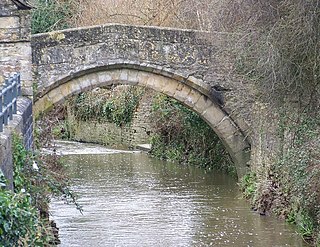
Bow Bridge is a 15th-century packhorse bridge over the River Brue in Plox, Bruton, Somerset, England. It has been designated as a Grade I listed building, and Scheduled Ancient Monument.
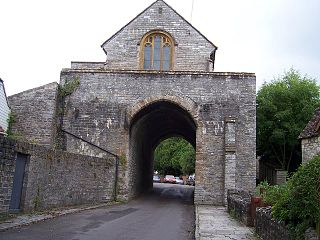
The Hanging Chapel in Langport, Somerset, England is a 13th-century archway, bearing a Perpendicular building known as the hanging chapel. It has been designated as a Grade I listed building, and a Scheduled Ancient Monument.

Abbey Farmhouse is a detached house in Montacute, Somerset, England, which incorporates the gateway of the medieval Montacute Priory. It was built in the 16th century and has been designated as a Grade I listed building.
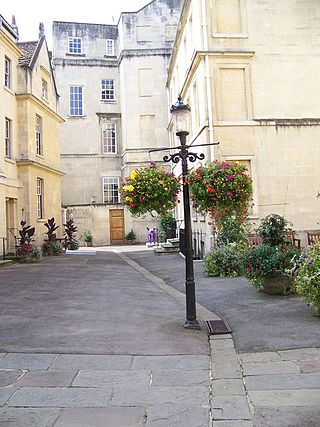
St John's Foundation was founded as St John's Hospital in Bath, Somerset, England, in 1174, by Bishop Reginald Fitz Jocelin and is among the oldest almshouses in England. The current building was erected in 1716 and has been designated as a Grade I listed building.

There are 72 Grade II* listed buildings in the city of Brighton and Hove, England. The city, on the English Channel coast approximately 52 miles (84 km) south of London, was formed as a unitary authority in 1997 by the merger of the neighbouring towns of Brighton and Hove. Queen Elizabeth II granted city status in 2000.

God's House Hospital, also known as the Hospital of St. Julian or Domus Dei is a refuge for poor travellers in Southampton, England. Much of the complex has now been destroyed, with only four buildings remaining: the gatehouse, God's House Tower, a grade I listed scheduled ancient monument; and the chapel, St. Julien's Church, a grade I listed building; and two accommodation blocks dating from the 19th century.
